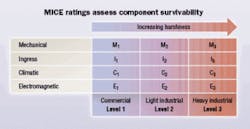The reconstruction of TIA-568
This is the second of a two-part series looking at the reorganization of the TIA-568 standard-the parent document for most “unique premises environments” standards. If you missed the first installment, check out Donna’s column from March (“568: The Next Generation”) by visiting www.cable-install.com.-Eds.
I had planned for this April’s column to be written after the TR-42 editors’ meeting where they are to begin the actual drafts of TIA-568-C.0 Generic Cabling and 568-C.1 Commercial Building Cabling. But my deadline loomed and their meeting has just gotten pushed into April.
Here’s the scoop
So, this is what I “know” so far...
As I mentioned last issue, their plan is to reorganize the TIA User Premises Telecommunications Cabling Infrastructure Standards by their “unique premises environments.” These will include TIA-568-C.1, Commercial; TIA-570-C, Residential; TIA-942-A, Data Centers; and TIA-1005-A, Industrial.
These “unique premises environments” will reference the “detail component specification” standards.
At this point, there will be one for all copper media components (TIA-568-C.2: Copper Cabling and Components), and one for all fiber media components (TIA 568-C.3: Optical Fiber Cabling and Components).
Forward-thinking
The “unique premises environments” will also reference the “generic” standards. In addition to TIA-568-C.0: Generic Telecommunications Cabling, the following are also considered as “generic” standards:
• TIA-569-C, Pathways and Spaces;• TIA-606-B, Administration;
• TIA-607-B, Bonding and Grounding;
• TIA-862-A, Building Automation Systems;
• TIA-758-B, Outside Plant.
It is important to note that all of the referenced documents are future editions of existing standards, so it is going to take several years-my guess is at least five-before the transition is completed.
For any new environmental standards, such as healthcare or K-12, the formulating subcommittee would use the generic standards and the detailed media standards as the basis, and then exclude the sections not relevant and draft only new material directly related to the latest environment being addressed. This should make the standards-writing process much more efficient and, hopefully, timelier. But there is a lot of reorganization to do before they get to that point.
568-C.0: All things common
So, what will be in the new TIA-568-C.0 Generic Cabling? All things seen as common to all structured cabling infrastructure systems:
Star topology. Currently, each of the “unique premises environments” standards is based on a hierarchical star architecture, so this requirement likely will be in TIA-568-C.0.
But there is a small problem with this approach. The spaces and the cabling between the spaces have different names in different standards, and changing these names within the documents would create a lot of confusion for the users. One example is the cable to an outlet in a commercial building is called the “horizontal cable,” but the cable to an outlet in a residence is called an “outlet cable.” Same cable, same outlet, but different names.
A solution currently being discussed is to have the TIA-568-C.0 requirements described in terms of connection points rather than specific space names, like MC (main cross-connect), IC (intermediate cross-connect), TR (telecommunications room), and links rather than specific names like backbone and horizontal cabling.
This would result in a requirement that all premises environments follow the hierarchical star architecture but allow each formulating group writing a standard for a unique premises environment to choose a distinctive naming convention for the spaces, etc., which types of media would be recognized, and the acceptable distance limitations for those types of media in this environment.
Permanent link and channel. TIA-568-C.0 likely will include the description of a permanent link and channel and how to field-test permanent links and channels. But the actual formulas used by the cabling component manufacturers and field-test manufacturers likely will remain in TIA-568-C.2 and TIA-568-C.3.
A better MICE trap
MICE. An acronym for Mechanical, Ingress, Climatic, and EMI, MICE is a rating system for the survivability of cabling components in varying degrees of environmental challenges.
Mechanical includes shock, vibration, crushing, and impact. Ingress includes liquid and dust particles. Climatic includes chemical, temperature, humidity, contaminants (both dry and liquid) and solar radiation. EMI (electromagnetic interference) includes electrostatic discharge (ESD), both radiated and conducted, transients, and magnetic fields.
Because MICE is applicable and scalable to all environments, it is logical that it will be included in C.0 and, in my opinion, the major real reason that this reorganization makes sense.
TIA-568-C.0 likely will include ESD mitigation techniques for copper cabling, polarity for optical-fiber cabling, and requirements for bonding cabling systems to ground.
TIA-568-C.0 will also likely include a list of what length of a specific medium can support specific applications. A similar list has previously been published in TIA-758-A, TIA-942, TIA-570-B, and TIA-568-B.1, demonstrating the need to remove duplication of information across the family of standards.
It is also interesting to note that no two of these standards have the same list.
TIA-568-C.1, C.2, and C.3
So, if everything described earlier is moving to TIA-568-C.0, what will be left in TIA-568-C.1, C.2, and C.3?
Requirements and guidelines specific to commercial building cabling will remain in TIA-568-C.1, as will a list of allowable media types, number and location of outlets, and the definitions of specific connection points and links. The requirements for TSB-162 Wireless likely will be incorporated into TIA-568-C.1.
TIA-568-C.2 Copper will include component and cabling specifications, and test limits, and will include the requirements previously in the 11 addenda to TIA-568-B.2 and TSB-155.
TIA-568-C.3 Optical Fiber will include component and cabling specifications and test limits, including requirements for laser-optimized fiber, previously in TIA-568-B.3 Addendum 1.
Where will the specifications for coaxial cabling being used in data centers and residences be published? Given the current workload in TR-42.7, my best guess is within those “unique environment” standards.DONNA BALLAST is BICSI’s standards representative, and a BICSI registered communications distribution design (RCDD). Send your questions to Donna at: [email protected]

